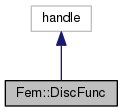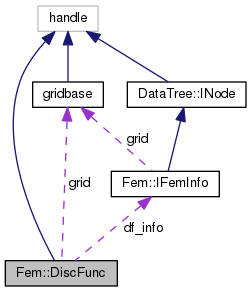|
rbmatlab
1.16.09
|
represents a continous piecewise polynomial function of arbitrary dimension. Can be used for all finite elements (discrete function information class) implementing IFeminfo (e.g. Fem.Lagrange.DefaultInfo)
\(dofs\) correspond to the values of the nodes. \(df_info\) is an object of discrete function information.
Definition at line 18 of file DiscFunc.m.


Public Member Functions | |
| DiscFunc (dofs,IFemInfo df_info) | |
| constructor, dofs possibly [], grid required! More... | |
| function cdf = | get_component (ncomp) |
| extraction of component of vectorial fem function ncomp can be vector More... | |
| function p = | plot (params) |
| plot as colormap, todo: ids as titles. enhanced subplots More... | |
| function res = | evaluate (einds, lcoord, varargin) |
| local evaluate on several elements More... | |
| function res = | evaluate_derivative (einds, lcoord) |
| computes the gradient in local coordinate res(:, i, j) is the x_i derivative of the j-th component More... | |
| function res = | l2_norm () |
| computes the l2-norm More... | |
| function res = | h10_norm () |
| computes h10-norm More... | |
| function res = | h1_norm () |
| computes h1-norm More... | |
| function res = | subsref (S) |
| This method enables indexation of discrete functions. More... | |
| function cdf = | copy () |
| copy More... | |
| function df3 = | plus (df2) |
| addition More... | |
| function df3 = | minus (df2) |
| subtraction More... | |
| function df2 = | uminus () |
| negative More... | |
| function df2 = | mtimes (df1) |
| multiplication More... | |
Public Attributes | |
| pdeg | |
| polynomial degree | |
| dimrange | |
| dimension of range space | |
| ::gridbase | grid |
| grid | |
| ::IFemInfo | df_info |
| discrete function information | |
| dofs | |
| DOF vector. | |
| nelements | |
| number of elements | |
| ndofs | |
| number of DOFs | |
| ndofs_per_element | |
| number of DOFs per grid element | |
| dofs_global_coordinate | |
| global coordinate of DOFs | |
| Fem.DiscFunc.DiscFunc | ( | dofs, | |
| IFemInfo | df_info | ||
| ) |
constructor, dofs possibly [], grid required!
| dofs | a vector of #df.ndofs global degress of freedom for the discrete function, if ==[] a zero vector is created. |
| df_info | object describing the structure of the underlying discrete function space |
pdeg — polynomial degree of lagrange functions dimrange — dimension of the range grid.nelements — number of overall elements (leaf + nonleaf) grid — grid ndofs — ndofs ndofs_per_element — ndofs per element get_global_dof_index — get global dof index dofs_lcoord — dofs lcoord Definition at line 113 of file DiscFunc.m.

| function cdf = Fem.DiscFunc.copy | ( | ) |
| function res = Fem.DiscFunc.evaluate | ( | einds, | |
| lcoord, | |||
| varargin | |||
| ) |
local evaluate on several elements
| einds | einds |
| lcoord | lcoord |
| varargin | varargin |
| res | res |
Definition at line 214 of file DiscFunc.m.


| function res = Fem.DiscFunc.evaluate_derivative | ( | einds, | |
| lcoord | |||
| ) |
computes the gradient in local coordinate res(:, i, j) is the x_i derivative of the j-th component
| einds | einds |
| lcoord | lcoord |
| res | res |
Definition at line 250 of file DiscFunc.m.

| function cdf = Fem.DiscFunc.get_component | ( | ncomp | ) |
extraction of component of vectorial fem function ncomp can be vector
| ncomp | ncomp |
| cdf | cdf |
Definition at line 156 of file DiscFunc.m.


| function res = Fem.DiscFunc.h10_norm | ( | ) |
| function res = Fem.DiscFunc.h1_norm | ( | ) |
| function res = Fem.DiscFunc.l2_norm | ( | ) |
| function df3 = Fem.DiscFunc.minus | ( | df2 | ) |
subtraction
| df2 | df2 |
| df3 | df3 |
dofs — dofsdofs — dofs Definition at line 411 of file DiscFunc.m.
| function df2 = Fem.DiscFunc.mtimes | ( | df1 | ) |
multiplication
| df1 | df1 |
| df2 | df2 |
df_info — df info dofs — dofsdofs — dofs Definition at line 448 of file DiscFunc.m.
| function p = Fem.DiscFunc.plot | ( | params | ) |
plot as colormap, todo: ids as titles. enhanced subplots
| params | params |
| p | p |
title — title Definition at line 173 of file DiscFunc.m.

| function df3 = Fem.DiscFunc.plus | ( | df2 | ) |
addition
| df2 | df2 |
| df3 | df3 |
dofs — dofsdofs — dofs Definition at line 390 of file DiscFunc.m.
| function res = Fem.DiscFunc.subsref | ( | S | ) |
This method enables indexation of discrete functions.
redirects arguments to evaluate function, so
| S | S |
| res | res |
subs — subs Definition at line 350 of file DiscFunc.m.

| function df2 = Fem.DiscFunc.uminus | ( | ) |
negative
| df2 | df2 |
dofs — dofs Definition at line 432 of file DiscFunc.m.
 1.8.8
1.8.8